
E-mail: font@focusonnature.com
Phone: Toll-free in USA 1-888-721-3255
or 302/529-1876
 |
PO Box 9021,
Wilmington, DE 19809, USA E-mail: font@focusonnature.com Phone: Toll-free in USA 1-888-721-3255 or 302/529-1876 |
HighlightS
FROM PREVIOUS
FOCUS ON NATURE TOURS
in PUERTO RICO
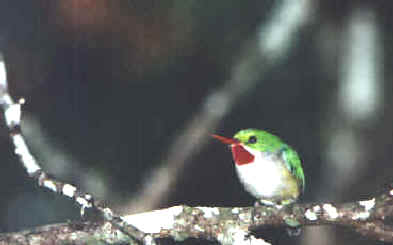
The
following summaries are with the most-recent tours first.
For some tours, there are links below to UPCOMING TOUR ITINERARIES, and lists (some
with photos) of BIRDS, MAMMALS, and OTHER NATURE.
Some Previous Tours:
April 2007 March 2004 March 2003 March 2002 February-March 2001
In the FONT Archives:
Some Photos of People, Places, & More during Previous FONT Tours in
Puerto Rico
In all, there have been 27 FONT tours in Puerto Rico.
Links:
More about FONT Birding & Nature Tours in Puerto Rico
Cumulative
List of Birds
during FONT Puerto Rico Tours
A List & Photo Gallery of Caribbean Birds, in 2 Parts:
Part #1: Guineafowl to Hummingbirds
Part #2: Trogons to Buntings
Mammals of the West Indies (with some photos)
Butterflies of the West Indies (with some photos)
Marine Life of the Caribbean (including Sea Turtles, Fish, Corals, Jellyfish, Mollusks, Arthropods)
Upcoming FONT Birding & Nature Tours in the West Indies including Puerto Rico
![]()
Link:
List
of Birds during our Puerto Rico Tour - April 2007
The following account written by Armas Hill, leader of the
tour.
This was our 27th
birding tour in Puerto Rico, and again a good one! Just about all of the endemic
and specialty birds that we sought were seen. (Unfortunately, the very rare
Puerto Rican Parrot has become quite difficult to find, and we did not see it as
we have in the past.) Among the fine birds that we did see were: White-tailed
Tropicbird, Key West Quail-Dove, Puerto Rican Lizard-Cuckoo, Puerto Rican Tody
(always a favorite), Adelaide's Warbler, and both the Puerto Rican
Spindalis and the Puerto Rican Tanager. At one rather remote spot in
southwestern Puerto Rico, we saw 4 members of the blackbird tribe at once: the
rare Yellow-shouldered Blackbird along with Greater Antillean
Grackles, the Shiny Cowbird, and the colorful Troupial. Not
long prior to that we had seen the Puerto Rican (formerly the Black-cowled)
Oriole, making 5 icterids seen during an hour. During 2 of our
nights, in addition to hearing the Coqui Frogs outside our rooms, we
heard the varied vocabulary of the Puerto Rican Screech-Owl.
After
the tour, we
received an inquiry from the editors of "Islands" Magazine,
asking some questions regarding our birding & nature tours in Puerto Rico:
What makes the tour unique?
What's a favorite aspect of the tour?
What are some things that a person wanting to join the tour should know?
And, when on the tour, is it easy or difficult?
Here we thought, in an e-mail bulletin, it might be good to share our answers to
these questions with you.
Probably what does make our FONT tours in Puerto Rico
"unique" (and we've done 27 such tours since 1990) is that we
spend much of our time in what might be called "the other Puerto
Rico", that is away from the resorts and the cruise ship docks, and
away from the metropolitan sprawl of San Juan.
Puerto Rico, with its countryside, is a beautiful island. Most of our time, during our PR tours, is in the western part of the island, where we visit a variety of habitats.
In forests, in the limestone or "haystack" hills of western Puerto Rico, there are not only interesting birds to find, there's an enjoyment of being in such a nice place.
The southwest corner of the
island (a dry habitat), both by the coast and inland, is a wonderful
place to be. There are cliffs by the sea, areas of lagoons, as well as some
places with cacti and others with luxuriant foliage. In all of these varied
places, we look at birds and other aspects of nature, such as the butterflies,
plants, and some non-avian wildlife.
From caves, at dusk, we see flying bats. Offshore, from a boat at sea,
we've observed not only oceanic birds (such as terns & tropicbirds),
but also the largest fish in the world (the Whale Shark).
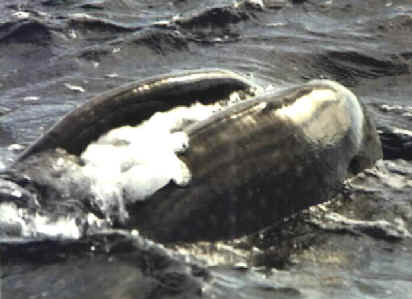
A Whale Shark photographed during an offshore boat-trip
as part of a FONT Puerto Rico Birding & Nature Tour.
(Photo
courtesy of tour participant Marie Z. Gardner.)
From shore, in northwest Puerto Rico, we've seen the even-larger whales
themselves, Humpbacks, breaching (that is, jumping) sometimes
completely out of the water.
Elsewhere along the Puerto Rican coast, the sluggish West Indian Manatees
spend nearly all of their time in the water.
But regarding the birds themselves, during our tours, we see about 100 species of them. Some of these are visitors during the winter from the places to the north (following pretty much the same calendar as many human tourists).
Other birds migrate through Puerto Rico, using it as a stepping-stone between North & South America.
And yet other birds are in Puerto Rico all-year long. A number of these are "endemics", that is species that occur no where else in the world. There are just over 15 bird species found only in Puerto Rico.
They include:
a very rare parrot (one of the rarest birds in the world),
a rare blackbird with yellow wings (called locally the "Mariquita"),
a marvelous little bird called the Tody, about 4 inches in length, with
an emerald-green back, a white breast, yellowish belly, and a bright red throat.
Among the other endemic birds, there are: 2 types of tanagers, 2 kinds of
warblers, 2 hummingbirds, a woodpecker, a cuckoo,
and an owl that during the dark of night gives a full repertoire of
sounds, including trills, chatter, and even a maniacal laugh.
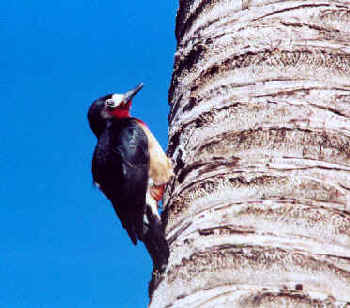
The Puerto Rican Woodpecker
If one were to have had a book
about Puerto Rican birds when JFK became president, two of the endemic birds of
the island would have been missing.
One, a nightjar (like a Whip-poor-will) that hides
by day, and catches insects around dusk and dawn and in between, was thought to
be extinct for over 70 years. It was re-discovered in 1961, and to this day, it
lives in a very restricted range in dense shrubbery the Puerto Rican dry forest.
The other bird that would not have been in the book is a small black-and-white warbler
that was discovered for the first time as recently as 1971. Even on populous
Puerto Rico that bird remained unknown to science for years! It's called the "Elfin
Woods Warbler" because it lives in small trees on mountaintops.
When many people think of nature in Puerto Rico, they think first of the rainforest, because a place known as "El Yunque" (a rainforest in the mountains east of San Juan) is well known. It is really a wonderful place, now preserved as a US National Forest. But, as noted earlier, it's just one of an assortment of habitats on the island. And so, it is just one of the places visited during the Focus On Nature Tours in Puerto Rico.
Yet one more member of the Puerto Rican cast of natural characters should be mentioned - the widespread Coqui Frogs. At night, their loud calls are heard continually. As easy to hear as they are, these little creatures, that are usually in trees, are hard to see. As frogs in much of the world have declined in recent decades, it's wonderful that the Coqui calls are such a prevalent and characteristic sound in Puerto Rican nature.
What's written so far has described what there is to like about the Puerto Rican touring. In summary, however, probably the favorite aspect of it is, yes, getting away from populated Puerto Rico, and being in that other world on the island that's beautiful and with nature. It sounds corny, but the contrast is tremendous.
Our favorite places in Puerto
Rico are two:
1) the virtually-unvisited forest in the "Haystack
Hills", and
2) the cliff by the lighthouse at the southwest corner of the island.
Unusual birds have been
mentioned, and among them there have been some "favorites". (It's hard to say just one. Well, no, we take that back - it's
the Tody!)
Our tour participants vote for their favorite birds at the end of the tours. The
Tody always wins!
A favorite restaurant is along the west coast of the island, jutting out over the water on a pier. The food there is really good, notably the seafood. People like it every day, and so do the Tarpons (large fish) in the water below the pier! During the day and after dark, people throw tidbits of left-over food into the clear water. The fish swimming about below in that water have clearly caught on to this apparently daily occurrence.
Joining a FONT birding &
nature tour in Puerto Rico is easy (although these tours are limited to small
groups of 6 or 7), and participation on the tours is easy as well. There's
no arduous hiking. The pace of the tour is not hurried. It's easy to pack
lightly as the weather is warm. It's not, when we go, too hot. Getting up early
is not a problem, as it's a wonderful time of day, and the best time for finding
the birds. And there's no concern regarding the meals. There's a good breakfast,
lunch ,and dinner every day.
During our tours, we stay in hotels, but those in more "natural"
settings. For example, in the hills in western Puerto Rico in the coffee-growing
country, or elsewhere, away from "busy" places where there's traffic,
a lot of buildings and many people. There are a number of nice places to stay in
Puerto Rico away from the crowds.
On a scale of 1 to 5 (easy to hard), let's say it's a 2. The hardest thing may be to leave the island at the end of the tour!
![]()
PUERTO
RICO & THE LESSER ANTILLES - March
2004
in the Lesser Antilles (St.
Lucia, St. Vincent, & Dominica)
"Parrots
of the Caribbean"
(and other birds too)
The following account written by Armas Hill, leader of the
tour.
Yes, it was parrots, not "pirates of the Caribbean" that were seen and enjoyed during our
Feb-Mar 2004 FONT West Indian birding tours in Puerto Rico and the Lesser Antilles.But, regarding the parrots during the tours, we saw all of them we sought. Including, the rarest of all in the wild, the Puerto Rican Parrot. During the Lesser Antilles tour, we saw four parrots known as amazons one on Saint Lucia, one on Saint Vincent, and two on Dominica. One of them on the last of these islands is the largest and the rarest of the Lesser Antillean parrots. It's the Imperial Parrot, called by the Dominicans, the "Sisserou", in Creole.
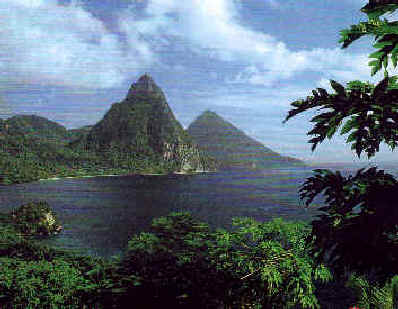
About 500 years ago, when the explorers from Spain entered the Caribbean, there were, in the West Indian islands, over 25 species of macaws, parrots, and parakeets. Since then, more than half have become extinct. The macaws, large and noisy, colorful but mostly red, were in Cuba, Hispaniola, and other islands including Guadeloupe and Dominica in the Lesser Antilles. Since the voyages of Columbus, all of the 7 or so species of Caribbean macaws have disappeared, as have 5 of the 8 native species of parakeets, and 3 of the dozen species of parrots. The last specimen of the Cuban Red Macaw was taken in 1864, but the species may have lingered remotely until the late 1800s (There are now 15 specimens in existence in museums).
The distribution of the parrots known as amazons in the Caribbean is interesting. As noted, there were prior to Columbus 12 species. Those on the larger Caribbean islands, oddly, are the smaller of the group, while those parrots on the smaller islands are the larger. Those on the Greater Antilles, mostly green, appear to have come east from Central America. Those in the Lesser Antilles, more strikingly colored, appear to have come north from South America. Formerly, there were such parrots on Guadeloupe and Martinique. They became extinct in the mid-1700s.
However, large and colorful amazon parrots continue, today, as noted, in forested mountains on 3 Lesser Antillean islands. And these birds were among the highlights of our 2004 tour.
The St. Lucia, or Versicolored, Parrot today numbers an estimated 350 to 500 birds. About 25 years ago, the population was only about 150 birds. The name "Versicolored" relates to the violet-blue and red in the plumage along with the green.
The St. Vincent Parrot was probably never very common. At one time, it was thought to be extinct. Today, it is found in only several wooded valleys, with a population of about 500 or slightly more. Some St. Vincent Parrots are predominately golden-brown, others more green. All have yellow-orange wing-patches, an orange-yellow hindcrown, and violet and yellow on the tail.
On the most rugged of the islands,
Dominica, 2 species of parrots continue, the more-common Red-necked Parrot,
and the more-rare Imperial Parrot. Over 40 per cent of Dominica is still
forested, but the parrots occur only locally on the island in the north.
Hurricanes in 1979 & 1980 annihilated the southern populations, particularly
that of the Imperial Parrot. The Imperial, among the largest and rarest of the
amazons, has the more secretive habits of the two Dominican parrots, often
staying beneath the forest canopy. Recent population estimates are 500-plus for
the Red-necked Parrot (up from 150 in 1980), and 250-plus for the Imperial.
About 10 years ago, in 1993, the Imperial Parrot population was only thought to
be about 80 individuals.
The Red-necked Parrot (known locally as the "Jaco"), is mostly
green, with, of course, a red neck (or rather a red throat), a red wing-patch,
and a blue crown, face, and chin.
The large mostly green-and-purple Imperial Parrot also has maroon-purple,
violet-blue, and reddish-brown in its plumage.
Earlier, during one of our days on Dominica, we had great looks at the Red-necked Parrot. In the mid-afternoon, we were at a lookout in the trees above a deep valley. Directly across from us, an Imperial Parrot landed, after calling as it flew over the valley. It sat in a bare treetop. When it landed there, the sun, that had been, for hours, mostly in the clouds, shone upon the colorful bird.
During an afternoon on Saint Vincent, from another lookout atop a hill in the forest, we had tremendous views of that island's colorful parrot, as pairs of them flew above and beneath us.
On St. Lucia, we enjoyed our "parrot experience" as well. During an afternoon and following morning, as they called and flew, we listened and watched.
But the rarest of all of the Caribbean amazons was seen during our Puerto Rico tour, that followed our time in the Lesser Antilles. The Puerto Rican Parrot has been critically endangered for years. Formerly occurring in various areas of the island, the bird has been very localized now for years, hanging on in a small hilly area in northeastern Puerto Rico. In 1975, there were only 13 Puerto Rican Parrots in the wild. From that unlucky low, the number about 10 years later was 30. In the late 1990s, the global population was 44 in the wild and 87 in captivity.
During our March 2004 Puerto Rico tour,
in the Luquillo Mountains, we saw one wild Puerto Rican Parrot. It was in the
vicinity of the facility with the birds in the captive breeding program, the
bird apparently drawn to the noise of the caged birds' calls in the afternoon.
It appeared to be a bird preferring to forfeit its lonely wildness for
companionship in captivity. (Parrots are social birds.)
The Puerto Rican Parrot
has now been seen during 11 FONT tours since 1990. The most was 12 in March
1996. The most-recent sighting, prior to this year, was in March 2000.
The Puerto Rican Parrot has come close to
following the fate of the parrots that once were in Guadeloupe and Martinique,
and the macaws that were in Cuba and elsewhere in the Caribbean. And, also in
Puerto Rico, a parakeet that formerly occurred, and is now extinct. It was until
about a hundred years ago that the "Puerto Rican Conure" flew about on
the island. It was a common subspecies of the Hispaniolan Parakeet, now
threatened on that island. Since that bird's demise on Puerto Rico, by the way,
resident subspecies of the Limpkin and a crow have also gone extinct there.
During our recent Puerto Rican tour, parakeets seen included some not-native,
the Monk and the White-winged (formerly Canary-winged), both indigenous to South
America.
Among the over-hundred species that were seen during our Puerto Rican tour, however, it's nice to note that among the birds endemic or nearly so to the island, there was a warbler not known to exist over 30 years ago (the Elfin Woods Warbler), a nightjar thought for many years (until about 1960) to be extinct (the Puerto Rican Nightjar), and a very-rare and localized bird, the Yellow-shouldered Blackbird. It was seen well, coming to a feeder along with a bird, recently arrived in Puerto Rico, that can cause it trouble, the Shiny Cowbird. Not exactly a Puerto Rican pirate (like the frigatebird), but a nesting parasite, the cowbird uses the nest of the blackbird. (The rare blackbird should not go the way of the birds that have been extirpated in Puerto Rico).
A complete listing of the birds that have been found during the 26 FONT birding tours that have been conducted in Puerto Rico can be found elsewhere in this web-site.
An interesting observation during our Puerto Rico tour this year related to a North American migrant. At a field, in southwestern Puerto Rico, in an area where we've always found something, we saw a sight we've never seen before. Out in a field, there were some leafless bushes with what appeared to be a large number of blue light-bulbs with a smaller number that were brown. In a scope, it was clear that they were Indigo Buntings, some in near-complete breeding plumage, some less so, but with a lighter (more lazuli-like) blue than dark indigo. A nice sighting for Bob from Minnesota who found them (and for the rest of us). The Indigo Bunting, by the way, is classified as uncommon in Puerto Rico in the winter, "in small numbers". We saw many (dozens) along with grassquits and other birds. During our previous 25 Puerto Rico tours, we've only seen 2 individual Indigo Buntings (both brown birds).
During our Lesser Antilles tour, on Dominica, a blue-brown bird appeared in tall grass along a roadside, an Indigo Bunting (found by Tom from New Jersey). It was our first-ever during a Lesser Antilles tour. The species is not even "in the book" for that island!
Also during that tour, as we were walking around some fish ponds, where we see the local Caribbean race of the Ringed Kingfisher, we turned to notice some egrets had landed on a nearby dike. All lined up, they were Cattle Egrets, except one. It was a Little Egret (our first for Dominica). It joined with the Cattle Egrets as they went to their evening roost.
We've seen Little Egrets in the past
during that tour on St Lucia (we saw 3 there in 2003 with Snowy
Egrets).
Little Egrets now breed in fair numbers on some lower Caribbean islands, such as
Barbados.
As did the Cattle Egret during the 20th century, Little Egrets appeared
(apparently from Africa) on lower Caribbean islands some years ago, and are now
appearing to spread. Bear in mind what has happened with the Cattle Egret
throughout the Western Hemisphere. It has spread north and south, and even as
far south as one sighting in Antarctica!
Our last "new" bird during the '04 Lesser Antilles tour was, as an odd twist, nearly our first bird on the '04 Puerto Rico tour, the White-tailed Tropicbird. We were, in Dominica, early in the morning, beneath a sea-side cliff where 10 or so were flying in, out, and about just above us. What a sight! In Puerto Rico, they were seen from the old fort, El Morro, at the entrance to San Juan Harbor.
Along the Dominican coast, we only saw 3
individual gulls. The most-common was Lesser Black-backed Gull (twice as
common as previous year). It was our 3rd consecutive year for Lesser Black-backed
Gull along that coast, with an adult each year at the very same place! (It's
only been there, we've been told, in the winter). In 2004, there were 2
Lesser Black-backed Gulls there, the adult and an immature with it.
The third gull, by the way, was a lone Laughing Gull.
During our March 2004 Puerto Rico tour,
oddly, not one gull was seen, not even a lone Laughing Gull.
Focus On Nature Tours will be going to the Caribbean again in 2011.
Parrots and hummingbirds and the like can also be seen during upcoming FONT tours in Central and South America.
![]()
The following account written by Armas Hill, leader of the tour.
In March 2003, we conducted the 25th FONT birding tour in
Puerto Rico.During the first day of that tour (late in the day, near the airport, following the arrival of all of the participants), a bird not seen during any of our previous Puerto Rico tours was seen along the seacoast near San Juan, a Red Knot. That species does not commonly occur in Puerto Rico in March.
The next morning, along the coast at San Juan, near the fort in the old city, there was a group of White-tailed Tropicbirds flying about. It was to be first of two groups of White-tailed Tropicbirds for us that day. Later we had a seafood lunch at an outside restaurant atop a coastal cliff further west on the island. Over the sea by the restaurant, we tallied as many as 10 White-tailed Tropicbirds in flight.
There are 16 species of birds endemic to the Puerto Rico and the nearby Virgin Islands. Of those, today 15 occur only in Puerto Rico. We saw all of them during our tour, except the Puerto Rican Parrot (ultra-rare now in the wild, and very hard to see in the restricted area where it nests in March). But all of the other endemics were seen, nearly all of them seen very well.
Even the Elfin Wood Warbler, a denizen of dense vegetation, not even known to science until about 30 years ago, was seen well.
Among the rarest of the endemics, the Puerto Rican Nightjar was seen quickly in flight above us, but it was seen. Actually, that evening just after sunset, the experience was wonderful. We walked a trail in the dry forest, heading uphill away from the sea. As darkness was falling, diurnal bird sounds were diminishing. Bats were quickly flying by us from their diurnal roost. Then, the call was heard of the rare Puerto Rican Nightjar, a bird "re-discovered" in 1961. Prior to that year, it was only known from fossils in a cave and a single specimen taken back in 1888. As we walked along the trail, we heard maybe 10 of the nightjars, some of them close, some further away. Responding to a tape, one flew over. The species normally hunts in flight for insects low above the ground, in the dense thickets of its restricted range. Our walk that night, beneath a clear sky filled with bright stars, and with the calls around us of a bird that was thought for years to be extinct, was something to remember.
Another of the rarest of worlds, endemic only to southwestern Puerto Rico, was seen well. The Yellow-shouldered Blackbird we normally see, during our tours, in a setting that can be said to be about as comfortable as it gets, poolside, by our seaside hotel. The bird, in the morning (and other times) frequents the palm trees there.
During our March '03 tour, in addition to seeing it there (according to plan), we also encountered the Yellow-shouldered Blackbird somewhat unexpectedly along the coast at a dry and hot spot adjacent to some salt flats. As we were walking in the afternoon by the flats (looking for Snowy Plover), 2 of the rare Yellow-shouldered Blackbirds flew in front us. They were heading to a pile of let's say fruit (a feeder of sorts) by a shack. We had very close looks at the birds feeding on the ground.
A short while later that afternoon, a few miles down the coastal dirt road, by a lagoon, also on the ground was a group of birds, tamely tuckered down in the sand. There were about 30 plovers, 5 of them Semipalmated, but 25 of them Wilson's Plovers in an assortment of plumages. A nice sight.
Also in southwestern Puerto Rico, but in a completely different habitat, there were some fine waterbirds at a small fresh-water marsh. In the thick surface vegetation of the small pond, heads of male and female Masked Ducks (2 pairs) were seen. On that surface, Soras walked and fed. Around the pond's edge, there were both both Moorhens and Purple Gallinules. Also at the little aquatic oasis, there were grebes, herons of various sorts, and some shorebirds, among them a Solitary Sandpiper or two (making it not so solitary).
On the relatively small island of Puerto Rico, in addition to the endemics and other native Caribbean birds, and some migrants from North America (such as a Hooded Warbler we saw in a woods in company with a resident Adelaide's Warbler), there were some birds that have lived there in the wild for years, having come originally from some far-flung places around the world. Puerto Rico is not over-run with such exotics, but it's possible to see some birds from distant places (saving, you might say, the expense of travelling afar). Accordingly, we saw the Troupial from Venezuela, the Monk Parakeet from Argentina, the Ringed Turtle-Dove from the Middle East, the Warbling Silverbill from southern Asia, the Bronze Mannikin (brought in the 1800's) from Africa, and the Orange-cheeked Waxbill from Africa as well. The House Sparrow, in recent years, has been spreading and increasing in Puerto Rico more than any of the other introduced species just mentioned.
Of course what we aim to see during the
tour is not the avian exotics, but rather the natives, including the endemics
and Caribbean specialties. And that we did.
Mentioning just a few more, we saw
such niceties as hummingbirds known as the Antillean Mango and Green-throated
Carib, in addition to the Antillean Crested Hummingbird.
And also
what's now called the Antillean Euphonia (it used to be called the
Blue-hooded Euphonia). Names and taxonomy do change.
What we now call the Puerto
Rican Spindalis was once referred to as the Stripe-headed Tanager. The
native oriole on Puerto Rico, once aligned with a population in Central
America and called the Black-cowled Oriole, has been shown to have more
affinities with the Lesser Antillean orioles, and not to be the same as the bird
on Hispaniola (also formerly conspecific with the Black-cowled
Oriole).
New
books and lists, with new names, will continue to be made.
![]()
The following account written by Armas Hill,
leader of the tour.
The March 2002 Puerto
Rico Tour was the 24th FONT birding tour on that island.
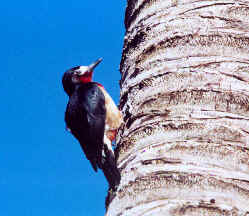
The Puerto Rican
Woodpecker,
one of the endemics during our March 2002 tour.
All of the avian endemics and specialties that we sought were seen well, with the exceptions of the very rare Puerto Rican Parrot, and the rare Puerto Rican Nightjar (which we heard well!).
Nearly a hundred species of birds were seen during the tour (including nearly all of 16 Puerto Rican endemics or near-endemics - as 1 or 2 of them also occur in the Virgin Islands).
If the Puerto Rican
Screech-Owl is still in the Virgin Islands, it's very rare there, but we had
some tremendous encounters with it in Puerto Rico. We saw 2, closely, sitting
together on a branch, after dark, dueting with their loud cackling calls. One
was light-colored with strong facial markings, the other quite reddish. During
another night, we saw another owl, also closely, looking at us, raising
it wing, and also making an assortment of noises. Its photograph is below.

Puerto Rican Screech Owl.
Changes in bird taxonomy have
changed what we say during our current Puerto Rican tours compared to
those in the past:
We now say "Puerto Rican Spindalis" instead of "Stripe-headed
Tanager". We say "Puerto Rican Pewee" rather than
"Lesser Antillean". We say "Greater Antillean" rather
than Black-cowled Oriole. And now we think of the Adelaide's
Warbler as a Puerto Rican endemic, since the split-off of the Barbuda
and St. Lucia Warblers.
West Indian Whistling-Ducks are very rare in Puerto Rico (we see
them more commonly to the west in Jamaica and the Cayman Islands). But we saw 3
during our March 2002 tour, in eastern Puerto Rico, as they flew into tall grass
by a pond. 4 Least Bitterns continued to be seen in the tall grass, and a
number of White-cheeked Pintails stayed in the open on the pond.
During our March 2002 tour, we
had wonderful looks at 2 Elfin Woods Warblers. Everyone in our group saw
them well, a feat, as the bird is notorious for giving fleeting glimpses as it
darts about in brushy undercover. Actually, the bird escaped detection by
ornithologists until just about 30 years ago.
We also enjoyed wonderful looks (in a comfortable setting: lawn and poolside) of
one of the rarest of birds, the Yellow-shouldered Blackbird.
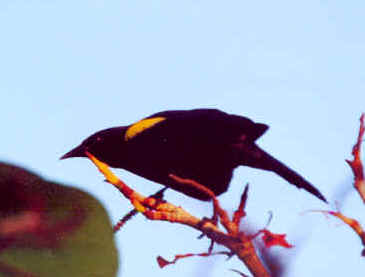
Yellow-shouldered
Blackbird
Photograph during March 2002 tour.
Sometimes the Mangrove Cuckoo can be hard to see, in, for example, Florida. In Puerto Rico, the species occurs in habitats other than mangroves, notably in dry areas. We saw this species very well, more than once, also in some pleasant settings along the southern coast of the island.
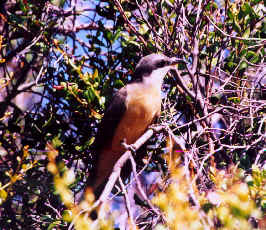
Mangrove
Cuckoo
Photographed during March 2002 Puerto Rico tour
But, it was in northern Puerto
Rico, in a beautiful forest in the Haystack Hills, we had an encounter with
another species of cuckoo, that was to be a foremost sighting of the tour. We
watched a Puerto Rican Lizard-Cuckoo watch us, as it did a circle in the
trees around us, calling as it went. It was voted our "top bird".
Over the years, the Puerto Rican Tody has received the "top bird
honor" more than any other. In 2002, the cuckoo notwithstanding, we still
loved the tody.
The "Top
Birds" as voted by participants after the tour were:
1 - Puerto Rican Lizard-Cuckoo
2 - Puerto Rican Tody
3 - Elfin Woods Warbler
4 - Puerto Rican Sreech-Owl
5 - Puerto Rican Woodpecker
6 - White-cheeked Pintail
7 - Puerto Rican Emerald
8 - Antillean Crested Hummingbird
(the male, a stunner!)
9 - Yellow-shouldered Blackbird
10 - "Puerto Rican Rooster" (they're
everywhere, seen & heard, yes heard!)
11 - Magnificent Frigatebird
12 - Mangrove Cuckoo
13 - Puerto Rican Spindalis
14 - Clapper Rail (watched
for a while)
15 - Adelaide's Warbler
16 - Venezuelan Troupial
The following letter was
received by FONT after the March 2002 Puerto Rico tour by participants, Bud and
Edna Schaffler, of Manahawkin, New Jersey, USA:
Dear Armas,
We want to express our appreciation to you for the wonderful
birding tour in Puerto Rico. You put together an excellent tour, and did a great
job leading. It was a trip we shall always remember.
The birds were great as was the scenery and the food. We hope
that next year we'll be able to join you on another tour in another area.
As noted above, we did not see
the very rare Puerto Rican Parrot in March 2002. The species, now very rare in
the wild (about 40 birds), nests during that month, with females on eggs.
However, in July 2002, when seeing the bird should be easier, we'll be doing
another Puerto Rican birding tour. A superlative effort will be made to see the
parrot at that time!
Itineraries
for upcoming FONT Puerto Rico tours
![]()
Dominican Republic
Puerto Rico
Cayman Islands
Jamaica
Again, in 2001, we had some very good birding during FONT tours in the Caribbean.
Just imagine - in the West Indies, sitting by a pool of water high in the pine-clad mountains of the
Dominican Republic, and watching about a dozen Hispaniolan White-winged Crossbills drinking at the waters edge. And with them, some colorful Andean Siskins.One day earlier, from a boat floating quietly on a nearby lake, imagine being surrounded by pink flamingos walking at times, in unison, and even-pinker Roseate Spoonbills moving their bills back-and-forth in the water as they fed, in the distance, endemic White-necked Crows were going to their evening roost in the palms.
The day before that, two species of todies, both of them bright and perky, were seen from along the same road - one in dry lowland shrub, the other in highland forest. Somewhere in between, along that road, there were in one tree, parrots, parakeets, and trogons.
Also during the
Dominican Republic tour there were birds such as tiny Vervain Hummingbirds, sitting and calling atop high perches, the rare (and rarely seen) La Selle's Thrush, and the unique Palmchat.
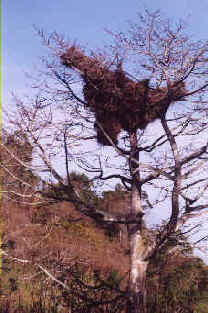
A huge,
abandoned nest of a colony of Palmchats,
in the Dominican Republic, near the
Haitian border.
The bird is endemic to Hispaniola.
(Photo by Jennie Gaitskill, during FONT birding tour, March 2001.)
Not an Hispaniolan endemic bird, but
particularly memorable to see during the March 2001 tour was a pair of
Prothonotary Warblers in a city botanical garden, close at hand - the male
displaying for the female, walking on a branch above a still stream, spreading
his tail. On the water, below, there were a pair of Least Grebes, with
chicks, ever so least - small bundles of striped fluff riding on the back of one
of the adults.
On the other side of the stream, there stood a Limpkin.
Memorable to hear, at another time during the tour, in the mountain forest, were
the echoing flute-like calls of the Rufous-throated Solitaire.
The
Puerto Rico Birding Tour, the previous week, had memorable moments, as well. During that tour (the 23rd Puerto Rico tour for FONT), all but one of the island's endemic birds were found - from the skulky Elfin Woods Warbler to the sometimes boisterous Lizard-Cuckoo. Other birds found included Masked Duck, on a pond with White-cheeked Pintails, and a Key West Quail-Dove.During the
FONT Jamaica Birding Tour this year, all of the endemic birds were found, including the often-elusive Jamaican Blackbird, and the Crested Quail-Dove. The latter, known locally as the "Mountain Witch", was seen very well - on the ground just feet away from us.During our tour on the
Cayman Islands, all of the bird specialties sought were found - the parrot, warbler, vireos, and bullfinch. And more from 2 to 3 hundred "rare" West Indian Whistling-Ducks.

West Indian Whistling-Ducks,
many places can be hard to see, but not here at this pool on the Cayman
Islands.
(Photo during FONT Feb. 2001 tour by Susan D'Amico)
Also seen during the FONT 2001 Cayman Islands Tour was a lone duck (actually a drake) certainly rare (more aptly, unheard of) in the Caribbean a male Baikal Teal, among many (hundreds of) Blue-winged Teal. With the Baikal behaving just as were the Blue-winged.
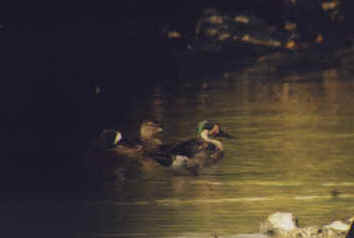
Male Baikal Teal
(right)
with male & female Blue-winged Teals
thru a telescope during FONT birding tour
on Little Cayman Island in the Caribbean, Feb. 24, 2001.
(Photo courtesy of Susan D'Amico.)
Not far from the Baikal Teal, on Little Cayman Island (10 miles long and 1 mile wide), and certainly more expected there, were numerous Red-footed Boobies (of both color morphs) and Magnificent Frigatebirds at their breeding colonies. Some males with big red sacs. Elsewhere, White-tailed Tropicbirds were seen (in flight among the seacoast).
Birding in the Caribbean is fun.
Itineraries
for upcoming FONT Caribbean tours and Lists of Birds & Otehr Nature
To
Top of Page